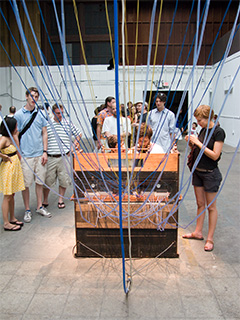
 I had a great time yesterday at David Byrne's Playing the Building auditory installation (running through August in the Battery Maritime Building in lower Manhattan). It involves an old organ console placed in the
middle of a semi-abandoned ferry terminal with various actuators hooked up throughout the building. The structure itself -- its pipes, columns, and so on -- makes the actual sound, under the control of whoever is
at the console. You can read more about the project at davidbyrne.com.
I had a great time yesterday at David Byrne's Playing the Building auditory installation (running through August in the Battery Maritime Building in lower Manhattan). It involves an old organ console placed in the
middle of a semi-abandoned ferry terminal with various actuators hooked up throughout the building. The structure itself -- its pipes, columns, and so on -- makes the actual sound, under the control of whoever is
at the console. You can read more about the project at davidbyrne.com.
Anyone can just go in and spend a few minutes playing the building. There's no real way to prepare ahead of time or directly apply expertise with another instrument; to make sound you have to experiment. So every performance by a visitor is by necessity an at least somewhat playful exploration. (There are apparently also occasional scheduled performances by musicians who've actually rehearsed with the contraption, but there wasn't one while I was there yesterday).
The result is surprisingly successful at blurring the distinctions between performer and audience, professional and amateur, work and play, signal and noise. An almost incidental side effect is some interesting, and occasionally hauntingly beautiful, ambient music. It reminded me of some of the early field recordings of Tony Schwartz (a terrific body of work I discovered, sadly, through his recent obituary on WNYC's "On the Media").
Given the nature of the piece, it was a bit incongruous to see almost everyone taking pictures of the console and the space, but hardly anyone recording the sound itself, at least while I was there. Presumably this has something to do with the relative ubiquity of small cameras versus small audio recorders, but I suspect there's more to it than that. The commercial and artistic establishment routinely prohibits "amateur" recording in "professional" performance spaces, and we've become conditioned to assume that that's just the natural order of things. (We're also expected to automatically consent to being recorded ourselves while in those same spaces, but maybe that's another story.) Amateur documentary field recording seems in danger of withering away even as the technology to do it becomes cheaper, better, and more available. In fifty years will we be able to find out what daily life in the early part of this century really sounded like?
Anyway, bucking this trend I happened to have a little pocket digital recorder with me and so I made a couple of brief recordings. (Here, I was cheerfully told, recording is perfectly fine.) Every minute or two a different (anonymous) visitor is at the console (there was a steady line). Most people played with a partner; a few soloed.
Each 256Kbps stereo .mp3 file is about 12 minutes long and about 21MB. I'll post the (huge) uncompressed PCM .wav files to freesound.org shortly.
- Track 1: Left-Right, 3:15pm [.mp3 audio]
Recorded at the center of the main room, facing toward the organ console. There are occasional footsteps, people talking, children running and laughing, etc. (which, I think, are best understood as being part of the "performance"), but the dominant sound here is the building itself being played. This perspective approximates being in the "audience".
 .
.
- Track 2: Rear-Front, 3:30pm [.mp3 audio]
Recorded near the console, oriented left channel toward the rear of the room and right toward the front. That is, the stereo image is rotated 90 degrees from the above and the mic position is much closer to the person playing. It includes more (and louder) talking and other sound from audience members, and because of the position some of the building sounds that would be quite loud in the center of the room are barely audible here. This perspective approximates what one hears while actually playing the building from the organ console.

(Note that these were not recorded at the same time; I only had the one recorder with me).
Technical note: All sound was recorded on July 5, 2008 with a handheld Nagra ARES-M miniature digital recorder via the "green band" clip-on XY microphone, in 16bit/48KHz/1536Kbps stereo PCM mode (converted to MP3 with Logic Pro 8).